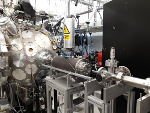| Version 33 (modified by , 6 years ago) ( diff ) |
|---|
Publications 2020
- May20: Long, K on behalf of the LhARA consortium: "Laser-hybrid Accelerator for Radiobiological Applications (LhARA)":
[Preprint, arXiv:2006.00493]
Submitted to Frontiers in Physics Medical Physics and Imaging
- Abstract
-
The ‘Laser-hybrid Accelerator for Radiobiological Applications’, LhARA, is conceived as a novel uniquely-flexible facility dedicated to the study of radiobiology. The technologies demonstrated in LhARA, which have wide application, may be developed to allow particle-beam therapy to be delivered in a completely new regime, combining a variety of ion species in a single treatment fraction and exploiting ultra-high dose rates. LhARA will be a hybrid accelerator system in which laser interactions drive the creation of a large flux of protons or light ions that are captured using a plasma (Gabor) lens and formed into a beam. The laser-driven source allows protons and ions to be captured at energies significantly above those that pertain in conventional facilities, thus evading the current space-charge limit on the instantaneous dose rate that can be delivered. The laser-hybrid approach, therefore, will allow radiobiological studies to be carried out in completely new regimes, delivering protons and light ions in a wide variety of time structures, spectral distributions, and spatial configurations at instantaneous dose rates up to and significantly beyond the ultra-high dose-rate ‘FLASH’ regime.
It is proposed that LhARA be developed in two stages. In the first stage, a programme of in-vitro experiments will be served with proton beams with energies between 10 MeV and 15 MeV. In stage two, the beam will be accelerated using a fixed-field accelerator (FFA). This will allow experiments to be carried out in vitro and in vivo with proton beam energies of up to 125 MeV. In addition, ion beams with energies up to 30 MeV per nucleon will be available for in-vitro an in-vivo experiments. This paper presents the conceptual design for LhARA and the R&D programme by which the LhARA consortium seeks to establish the facility.
- Figures:
| Fig. 1 | Fig. 2 | Fig. 3 | Fig. 4 | Fig. 5 | Fig. 6 | Fig. 7 | Fig. 8 | Fig. 9a | Fig. 9b | Fig. 10 | Fig. 11 |
Attachments (16)
- LhARA-preCDR-arXiv.pdf (2.1 MB ) - added by 6 years ago.
- Capture.png (144.9 KB ) - added by 6 years ago.
- EndStationPhaseSpace.pdf (272.3 KB ) - added by 6 years ago.
- optics.pdf (27.0 KB ) - added by 6 years ago.
- injmatch0f.pdf (4.3 KB ) - added by 6 years ago.
- LhARA_Ring_Stage2.pdf (98.0 KB ) - added by 6 years ago.
- FFAFigs.pdf (450.6 KB ) - added by 6 years ago.
- s1EndStation_mono_annot.png (46.5 KB ) - added by 6 years ago.
- invitro_madxvsbdsim_40mev_beta_fix.png (43.1 KB ) - added by 6 years ago.
- invitro_madxvsbdsim_127p4mev_beta_fix.png (47.0 KB ) - added by 6 years ago.
- BDSImvsMADX_invivo.pdf (200.9 KB ) - added by 6 years ago.
- injmatch0f.png (90.4 KB ) - added by 6 years ago.
- injmatch0f-thumb.png (6.6 KB ) - added by 6 years ago.
- LhARA-v4-3.pdf (201.2 KB ) - added by 5 years ago.
- stage1overview.pdf (100.3 KB ) - added by 5 years ago.
- stage1overview.png (92.6 KB ) - added by 5 years ago.
Download all attachments as: .zip
